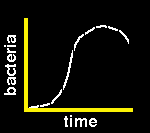Video: Bacteria Divide and Multiply
 Connections
Connections 
- Test drive the Bacteria Cam
- Visit the Bacteria Cell Model
- Take the Microbes Quiz
- Watch them Tumble and Swim
Binary Fission in E. coli
In this video, see how two E. coli, given a suitable environment for growth, divide and form a colony of hundreds of bacteria in about three hours. Then visit the CELLS alive! Bacteria BioCam to follow a colony of bacteria in "real time".
Bacteria are all around us. Given good growing conditions, a bacterium grows slightly in size or length, a new cell wall grows through the center forming two daughter cells, each with the same genetic material as the parent cell. If the environment is optimum, the two daughter cells may divide into four in 20 minutes. Oh my! 1, 2, 4, 8, 16, 32, 64... Then why isn't the earth covered with bacteria?
The primary reason may be that conditions are rarely optimum. Scientists who study bacteria try to create the optimum environment in the lab: culture medium with the necessary energy source, nutrients, pH, and temperature, in which bacteria grow predictably.
 LAG PHASE: Growth is slow at first, while the "bugs" acclimate to the food and nutrients in their new habitat.
LAG PHASE: Growth is slow at first, while the "bugs" acclimate to the food and nutrients in their new habitat.
LOG PHASE: Once the metabolic machinery is running, they start multiplying exponentially, doubling in number every few minutes.
STATIONARY PHASE: As more and more bugs are competing for dwindling food and nutrients, booming growth stops and the number of bacteria stabilizes.
DEATH PHASE: Toxic waste products build up, food is depleted and the bugs begin to die.
Bacterial Infection and Fever
Laboratory growth of bacteria does not tell you how they will multiply in the body. Not only do invading bacteria need to be where there is nutrient to support growth and strategies for tolerating the immune system, but also they require an optimum temperature.
